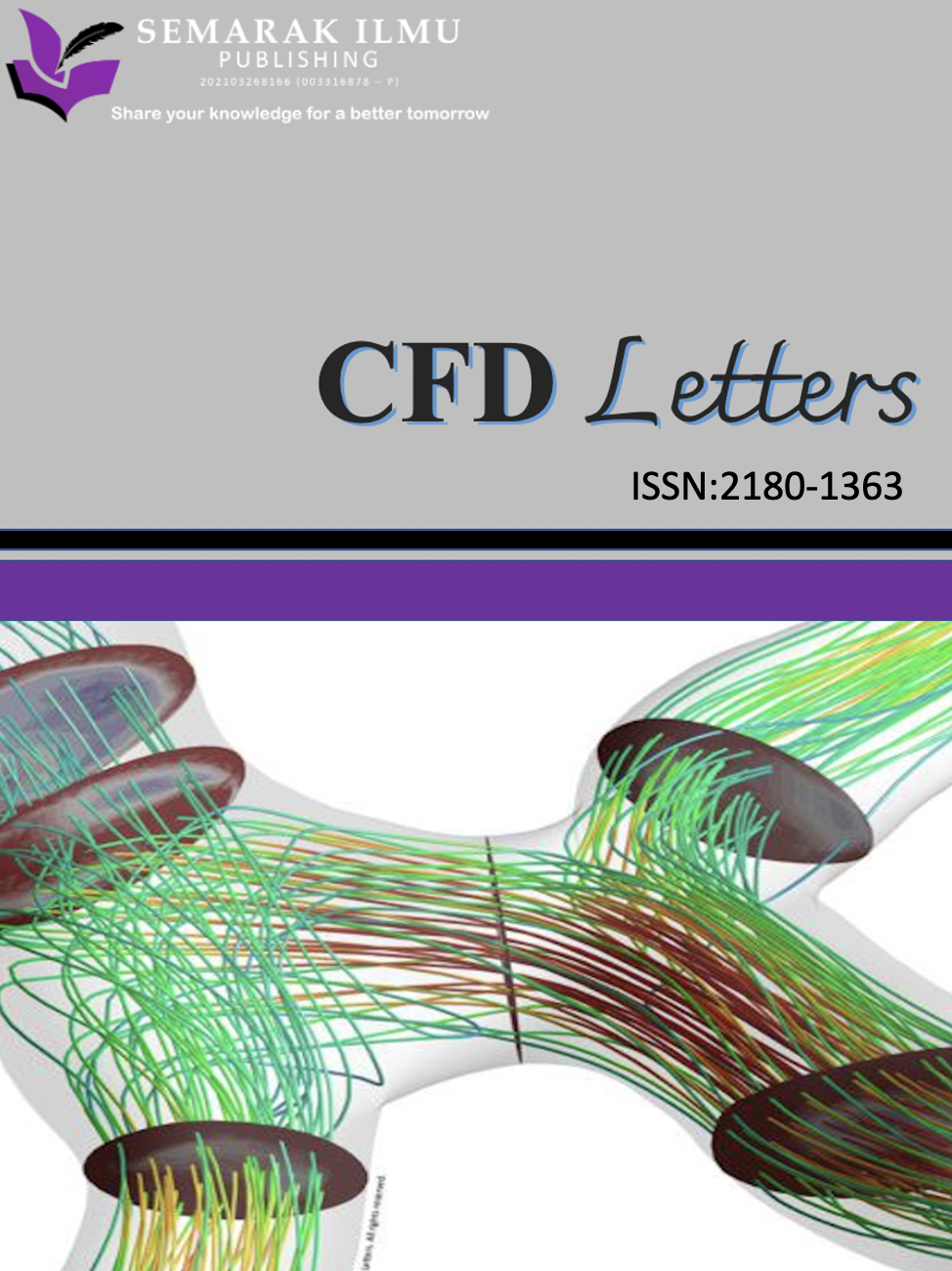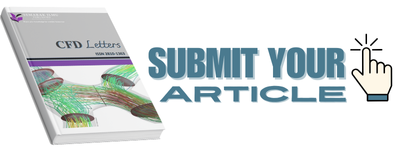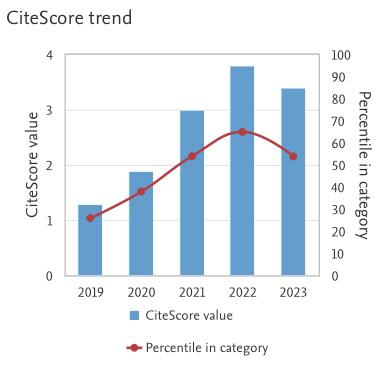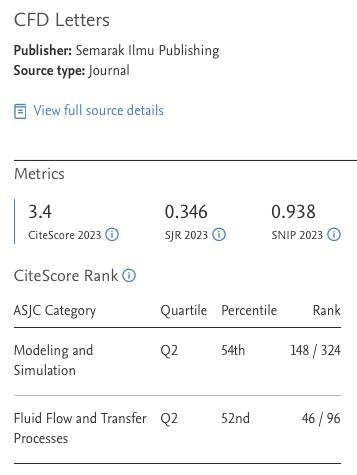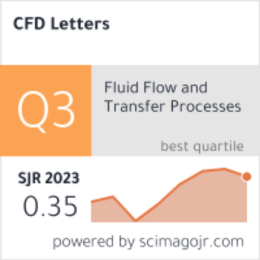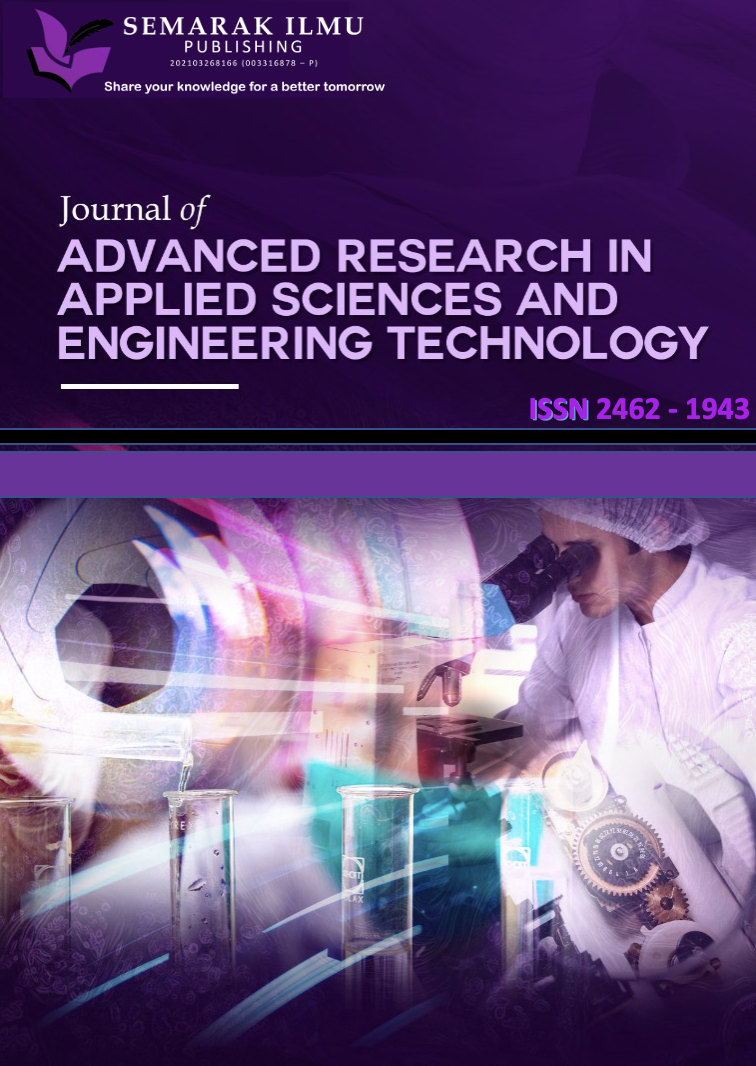3D Computational Fluid Dynamic Investigation on Wave Transmission behind Low-Crested Submerged Geo-Bag Breakwater
DOI:
https://doi.org/10.37934/cfdl.15.10.1222Keywords:
Submerged Breakwaters, Transmission Coefficients, computational fluid dynamics (CFD), Experimental Tests, Wave TransformationsAbstract
Wave transmission characteristics behind low-crested submerged breakwaters involve complex-hydrodynamic interaction of water waves on the structures. To properly comprehend the induced-nonlinear wave transformation, the problem necessitates a trustworthy prediction using a computational fluid dynamic (CFD) technique. The goal of this study is to develop a three-dimensional (3-D) computational model of the hydrodynamic performance of a narrow crest behind a submerged breakwater in order to gain a thorough understanding of the wave transmission coefficient, K_t. The simulation took into account a number of wave parameters such as wave steepness (H_i⁄L), relative submergence depth (H_i⁄h), and crest width (c_w⁄L) of the structure. A numerical wave flume model is included, which is based on the full Navier-Stokes solver and includes a shallow water model to account for nonlinearity in the incident wave field. In addition, laboratory measurements were also conducted using a geo-bag dike model as the main breakwater structure. The result shows that the reduction in transmission coefficient correlates highly with the wave steepness and the relative submergence and crest parameters. This can be attributed to most breaking waves over the submerged breakwater. The steeper the incident wave, the greater the reduction in the transmitted wave. And, the greater the principal dimensions of the breakwater, the greater the drop in transmission coefficient. For validation, the CFD results corroborate satisfactorily with measurements
Downloads
References
Hashim, Ahmad Mustafa, Nur Diyana Md Noor, and Siti Nur Hanis Abdullah. "Wave Attenuation of Interlocking Concrete Unit-V (ICU-V)." Applied Mechanics and Materials 567 (2014): 313-318. https://doi.org/10.4028/www.scientific.net/AMM.567.313
Srisuwan, Chatchawin, and Payom Rattanamanee. "Modeling of Seadome as artificial reefs for coastal wave attenuation." Ocean Engineering 103 (2015): 198-210. https://doi.org/10.1016/j.oceaneng.2015.04.069
Lorenzoni, Carlo, Matteo Postacchini, Maurizio Brocchini, and Alessandro Mancinelli. "Experimental study of the short-term efficiency of different breakwater configurations on beach protection." Journal of Ocean Engineering and Marine Energy 2, no. 2 (2016): 195-210. https://doi.org/10.1007/s40722-016-0051-9
Díaz-Carrasco, Pilar, Mª Victoria Moragues, María Clavero, and Miguel Á. Losada. "2D water-wave interaction with permeable and impermeable slopes: Dimensional analysis and experimental overview." Coastal Engineering 158 (2020): 103682. https://doi.org/10.1016/j.coastaleng.2020.103682
Vanneste, Dieter, and Peter Troch. "2D numerical simulation of large-scale physical model tests of wave interaction with a rubble-mound breakwater." Coastal Engineering 103 (2015): 22-41. https://doi.org/10.1016/j.coastaleng.2015.05.008
Jacobsen, Niels G., Marcel RA van Gent, and Guido Wolters. "Numerical analysis of the interaction of irregular waves with two dimensional permeable coastal structures." Coastal Engineering 102 (2015): 13-29. https://doi.org/10.1016/j.coastaleng.2015.05.004
Liu, Yong, and Hua-Jun Li. "Analysis of wave interaction with submerged perforated semi-circular breakwaters through multipole method." Applied Ocean Research 34 (2012): 164-172. https://doi.org/10.1016/j.apor.2011.08.003
Mizutani, Norimi, Ayman M. Mostafa, and Koichiro Iwata. "Nonlinear regular wave, submerged breakwater and seabed dynamic interaction." Coastal Engineering 33, no. 2-3 (1998): 177-202. https://doi.org/10.1016/S0378-3839(98)00008-8
Losada, I. J., R. Silva, and M. A. Losada. "3-D non-breaking regular wave interaction with submerged breakwaters." Coastal Engineering 28, no. 1-4 (1996): 229-248. https://doi.org/10.1016/0378-3839(96)00019-1
Huang, Ching-Jer, Hsing-Han Chang, and Hwung-Hweng Hwung. "Structural permeability effects on the interaction of a solitary wave and a submerged breakwater." Coastal engineering 49, no. 1-2 (2003): 1-24. https://doi.org/10.1016/S0378-3839(03)00034-6
Corvaro, S., E. Seta, A. Mancinelli, and M. Brocchini. "Flow dynamics on a porous medium." Coastal Engineering 91 (2014): 280-298. https://doi.org/10.1016/j.coastaleng.2014.06.001
Abdullah, Sheikh Fakhruradzi, Ahmad Fitriadhy, and Safari Mat Desa. "Numerical and experimental investigations of wave transmission behind a submerged WABCORE breakwater in low wave regime." Journal of Ocean Engineering and Marine Energy 7 (2021): 405-420. https://doi.org/10.1007/s40722-021-00209-8
Fitriadhy, Ahmad, Nur Amira Adam, Nurul Aqilah Mansor, Mohammad Fadhli Ahmad, Ahmad Jusoh, Noraieni Hj Mokhtar, and Mohd Sofiyan Sulaiman. "CFD Investigation into The Effect of Heave Plate on Vertical Motion Responses of a Floating Jetty." CFD Letters 12, no. 5 (2020): 24-35. https://doi.org/10.37934/cfdl.12.5.2435
Fitriadhy, Ahmad, Nurul Aqilah Mansor, Nur Adlina Aldin, and Adi Maimun. "CFD analysis on course stability of an asymmetrical bridle towline model of a towed ship." CFD Letters 11, no. 12 (2019): 43-52.
Jehad, D. G., G. A. Hashim, A. Kadhim Zarzoor, and CS Nor Azwadi. "Numerical study of turbulent flow over backward-facing step with different turbulence models." Journal of Advanced Research Design 4, no. 1 (2015): 20-27.
Goda, Yoshimi, and Yasumasa Suzuki. "Estimation of incident and reflected waves in random wave experiments." In Coastal Engineering 1976, pp. 828-845. 1976. https://doi.org/10.1061/9780872620834.048






